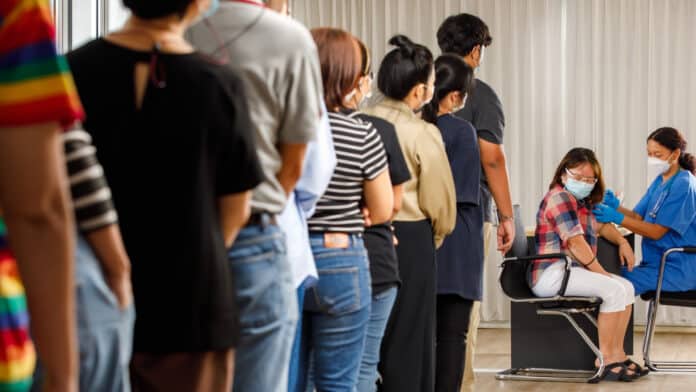A new study led by Yale University, the University of Florida, and the Connecticut Department of Correction discovered that high levels of COVID-19 viral exposure could reduce the protection provided by vaccination and prior infection.
The finding suggests that control measures that reduce virus exposure, such as masking, improved ventilation, and distancing, prevent new infections in people vaccinated or previously infected.
The study, conducted within the Connecticut Department of Correction system, aimed to determine if immunity gained by vaccination or a past infection was less effective or “leaky” when people were exposed to high virus levels. Because it is difficult to find a population like the Connecticut Department of Correction’s residents who are aware of each individual’s kind of exposure, vaccination status, and history of medical conditions.
Dr. Byron Kennedy, chief medical officer for the Connecticut Department of Correction and associate clinical professor at the Yale School of Public Health, added, “We had a unique opportunity to answer this question because the Department of Correction had mounted an intensive COVID-19 testing program and we were identifying and isolating infected individuals.”
The new study offers real-world evidence for the exposure-dependent or “leaky” nature of immunity provided by vaccination and infection. The researchers tracked conditions in Connecticut correctional institutions among 15,444 people between June 2021 and May 2022, when the state witnessed two epidemic waves caused by the COVID-19 Delta and Omicron variants. They also determined whether persons had lived with a COVID-19-positive cellmate and, as a result, had high COVID-19 viral exposure.
Vaccination was 68% successful in avoiding infection in persons without a recorded exposure during the Delta wave but only 26% effective in those with cellmate exposure. A prior infection was 79% effective in residents who had not been exposed before but only 41% effective when exposed to an infected individual in their cells. Hybrid immunity gave the best protection, with 95% and 71% efficacy, respectively.
The study discovered that during the Delta and Omicron epidemic waves, immunity obtained after a vaccine, prior infection, or both vaccination and infection (“hybrid immunity”) was poorer when residents lived with an infected immate. Vaccination was successful in 43% of residents who had no recorded exposure but just 4% of residents who shared a cell with an infected individual. Hybrid immunity was just 20% effective in people with recorded exposure but 76% effective in individuals without documented exposure. These patterns indicate that vaccination, previous infection, and hybrid immunity are essential for viral prevention.
He said, “The success of contact tracing was critical in keeping our population safe in this high-risk congregate setting during the pandemic.”
During the two epidemic waves, residents were at a 5-10 times higher risk of infection if they shared a cell with an infected person and a 2-4 times higher risk if an infected person was in the same cell block. Most infections were discovered through the Department of Corrections contact tracing program.
More research is needed to determine whether a similar phenomenon of leaky protection occurs in vaccinated and previously infected persons in other congregate settings, such as hospitals and nursing homes, as well as in the community during mass meetings.
“We suspect that leaky protection may be the norm for immunity to many infectious diseases of public health importance.” said Dr. Albert Ko, the Raj and Indra Nooyi Professor of Public Health at the Yale School of Public Health and co-senior author of the paper.
The researcher said, “This study is a good example of leveraging collaboration between the state government and a university to answer a difficult yet fundamental question on how immunity to COVID-19 works, in addition to guiding how we protect our vulnerable populations.”
Journal Reference:
- Amy J. Houde, Murilo Dorion, et al. Evidence of leaky protection following COVID-19 vaccination and SARS-CoV-2 infection in an incarcerated population. Nature Communications. DOI: 10.1038/s41467-023-40750-8
